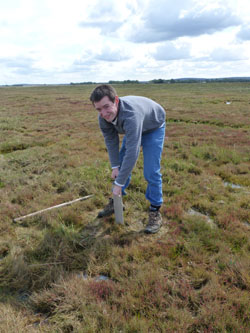A study to investigate the levels of dangerous metals in the Faversham Creek and Oare Creek has been performed by Robert Gunning, a student at the University of Greenwich. Gunning, who is pursuing a degree in Environmental Sciences, conducted this nine-month research. This study was performed on the marshes, while earlier studies were done on the mud flats of the creeks.

Robert Gunning at work in Faversham Creek
Both the creeks have a long history of use for industrial purposes. They had contained a commercial port, and facilities for barge construction and production of gunpowder. Explosives had been produced and mercury had been used for production of detonators. It is possible that mercury might have come from pesticides, which were earlier employed in agriculture and may also be present in the creeks. However, determination of low levels of mercury is quite difficult.
The researcher took core samples from depths of around 80 cm, which is sufficient to reach to pre-industrial levels. The samples were taken from both the creeks stretching at for a distance of 5 mi. A detailed analysis was performed at the University of Greenwich laboratory on the Medway Campus. The levels of various metals such as mercury, chromium, nickel, tin, cadmium, copper and lead were observed.
The study revealed traces of mercury that are considered to be on safe levels. These levels are similar to those in the Thames and the River Medway.
The results of the student study will help the Environment Agency to assess background contamination of other creeks.
Disclaimer: The views expressed here are those of the author expressed in their private capacity and do not necessarily represent the views of AZoM.com Limited T/A AZoNetwork the owner and operator of this website. This disclaimer forms part of the Terms and conditions of use of this website.